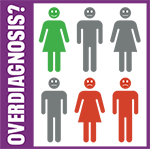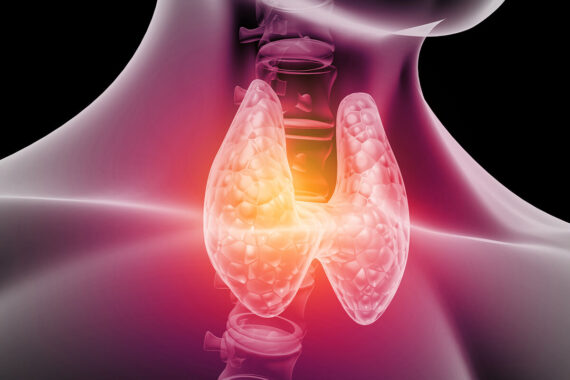
As part of our series on conditions that may be overdiagnosed, GP Dr Peter Bagshaw considers whether we over-diagnose hypothyroidism and should instead consider other causes
Background
Tiredness is a common symptom, so it is not surprising that many patients would like a simple solution. While tiredness is one of the symptoms of hypothyroidism, there are many other causes to consider.
In recent years, social media have amplified the idea that undiagnosed thyroid disorders are common causes of tiredness and low energy. There is an even broader trend to blame medics for not taking tiredness seriously.
Actual prevalence
Hypothyroidism is found in 1-2% of the UK population and in more than 5% of people over 60. Women are five to 10 times more likely to be affected than men.1 NICE states that ‘subclinical hypothyroidism may have been overestimated in older people’, with age-related physiological increase in TSH levels being misinterpreted as thyroid disease.’1
Common features
Fatigue, weight gain, cold intolerance, dry skin and hair, muscle and joint pain, constipation, depression and mood changes, memory and cognitive problems, menstrual irregularities and elevated cholesterol levels are all classic features of hypothyroidism. Often only a few of these symptoms are present. Subclinical hypothyroidism (defined as raised TSH but normal T3/T4) may be asymptomatic.
Reasons for overdiagnosis
Symptoms of hypothyroidism are common. One Swiss study found prevalence of fatigue was 21.9% in the general population.2 Patients’ research, or even well-meaning friends, may identify hypothyroidism as a potential cause. Hypothyroidism is also easier to address than lifestyle or mental health causes.
The chances of an abnormal thyroid blood test in this group is high. Subclinical hypothyroidism affects 5–10% of the population.3 Often these abnormalities are transient and return to normal when repeated, but patients will often latch onto the transient abnormality as the cause of their symptoms.
Supporting the patient’s next steps
If both TSH is raised and free thyroxine (FT4) is reduced, the diagnosis is likely to be correct and we should start treatment. Given the high incidence of tiredness from other causes, it is important to explain that correcting thyroid function may not always abolish symptoms.
The situation is very different when the patient has a raised TSH and normal (or not measured) FT4. Given the relative incidence of asymptomatic subclinical hypothyroidism, rushing to treatment is not advised. NICE recommends if patients are not pregnant, to repeat TFTs after three to six months to exclude other causes of a transiently raised TSH and to confirm the diagnosis.1
Broader issues
Borderline hypothyroidism is the subject of controversy. Several studies point out that treating subclinical hypothyroidism, which can revert to normal spontaneously, has no clinical benefits.4 Some criticise ‘over-reliance on a single laboratory parameter, TSH’.5 However, relying on patient wellbeing, as some studies recommend, can be difficult when many patients report feeling better if they run slightly hyperthyroid. In addition, support groups debate the relative benefits of levothyroxine, liothyronine or desiccated thyroid extract. GPs may be asked to advise on these.
Overall, we should try to stick to NICE guidance: a mildly abnormal TSH alone is unlikely to be the cause of the patient’s symptoms. Holding off treatment and repeating TSH and FT4 six weeks later may not make us popular with our patients, but it is the right thing to do, and may reduce harmful overtreatment.
Dr Peter Bagshaw is a GP in Minehead, Somerset
References
- NICE Clinical Knowledge Summary: Hypothyroidism. 2021. Link
- Galland-Decker C et al. (2019) Prevalence and factors associated with fatigue in the Lausanne middle-aged population: a population-based, cross-sectional survey. BMJ Open 9(8),1-10. Link
- Okosieme O et al. Management of primary hypothyroidism: statement by the British Thyroid Association Executive Committee. Clin Endocrinol 2016;84:799-808. Link
- Calissendorff J and Falhammar H. To treat or not to treat subclinical hypothyroidism, what is the evidence? Medicina 2020;56:40. Link
- Midgley J et al. Time for a reassessment of the treatment of hypothyroidism. BMC Endocr Disord 2019;19:37. Link
Pulse October survey
Take our July 2025 survey to potentially win £1.000 worth of tokens





 Oviva’s fully remote Tier 3 Weight Management programme
Oviva’s fully remote Tier 3 Weight Management programme







I would definitely agree with all the above, having seen some patients who have insisted on sequential dose increases to dangerous levels (usually by mail-order, then demand from GP) because the tiredness or dry skin persists – failing to believe that there might eb any other possible cause – and we must not forget that there are many other possible causes for every single symptom of hypothyroidism!
I have also seen patients commenced on T4 because of a single acute (and possibly quite markedly) raised TSH during an acute phase illness without relevant symptoms; and on the other hand patients stable on T4 for many years following a secure diagnosis by GP, having their dose stopped suddenly and told to not have it checked ever again because of a single normal TSH in hospital! (just in case anyone wonders, NICE guidance is currently that the T4 dose is correct if the TSH is within ‘normal range’ for a patient taking supplements, BUT a high TSH could be for acute phase reaction reasons, such as, in the elderly, an UTI). Low TSH almost always (but not quite) indicates over-dosing, but often occurs on necessary supplements when T4 level is just within normal corrected range, depending on your lab.